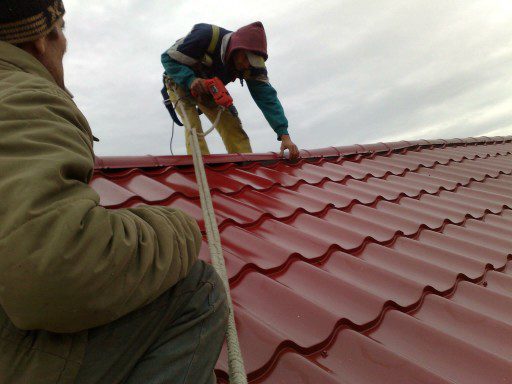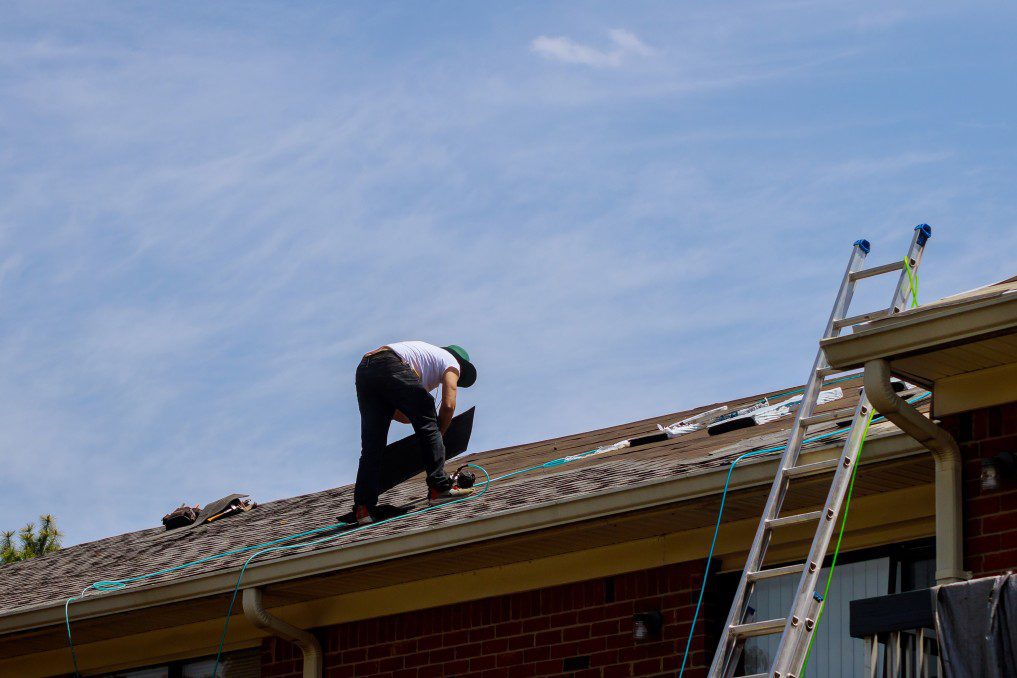

Clay and concrete, the most common materials used to make roof tiles these days, offer several advantageous properties. They’re long-lasting, beneficial to the environment, and very hardy when it comes to storms and fire.
If you need to repair your roof, walking on a roof will help you to analyze the problem but may put you in danger- if done incorrectly. To get the most out of your clay and concrete tiles, it’s important not to put too much weight on them when walking on a roof.
The top ends of concrete and other roof tiles are fastened to the structure using nails. The lower ends of the tiles below them lie on the higher ends of the lower tiles. As a result, a tiled roof is neither static nor dynamic. As a result, we must use extreme caution while walking on a roof.
Because of the tiny gravel chip used and the lack of steel reinforcement, concrete tiles have the potential to be fragile. It is thus possible for them to shatter or even break when subjected to excessive stress. Hairline cracks may be difficult to detect, yet they can allow moisture to enter.
Although the tiles are robust, they are not intended to be walked on. However, there may be instances where walking on a roof is an unavoidable circumstance. Essentially when walking on a roof, clay, or concrete tiles, knowing how to do so securely and without damaging the tiles is paramount.

Safety should always come first. Ensure you have everything you need, including non-slip footwear, gloves, and a safety harness.
Disconnect the gutter system from the water tank if you used it during the cleaning procedure since several chemicals may have been utilized. Check the water tank.
It’s essential to get rid of moss and algae since they may pile up and eventually cover most roof tiles.
It is best to use mild brushes and water hoses to wash the roof rather than high-pressure water, which might damage the tiles. Before climbing on your roof, make sure the tiles are completely dry.
It’s challenging to get a good hold on tiles because of their flat, smooth surface. It’s dangerous to walk on wet tiles because they become considerably slicker and more dangerous when wet.
Do not stand on wet tiles for at least two days if you have just had rain or your roof is damp for any other reason.
To avoid damaging the tiles, use shoes with soft soles. Consider sneakers or light work boots with soft rubber bottoms with grips for improved traction on the tiles when walking on them. Avoid wearing heavy shoes or boots with a firm base because they’re more prone to shatter tiles and make it difficult to walk about.
Shoes with exposed toes, such as sandals and flip-flops, provide little protection if you should slip or fall.
The roofers in our company use shoes spcifically designed for roofing called Cougar Paws. These are amazing as they have an extremely slip proof sole. This is essential for the roofs in Pennsylvania because the pitch is usually 7/12 and higher.
TJ Hoffman | Owns Roofing Company in Bloomsburg, PA
To ensure a safe ascent, use a ladder that rises at least three feet (0.91 m) over the rim of your roof. Make sure the ladder is on level ground and at least one-fourth of its height away from your house.
Keep three points of contact with the ladder to avoid slipping and falling. Ask a friend or family member to keep the ladder steady for you as you climb it.
If your roof is very steep, a safety harness is a must. Safety harnesses save you from falling to the ground if you slip on your roof. Tighten the safety harness around your thighs by putting your legs through the loops.
Secure the harness’s top by wrapping it around your waist and pulling it snugly. Roofs with chimneys and vents can be used as an anchor to stop you from falling; use a rope and tie it around your chimney.
Safety harnesses are available for purchase online or at a home improvement shop. Ropes may be used to build your custom harness. You don’t need a safety harness on a flat roof, but it’s still a good idea to wear one if you’re concerned about falling.
To reach the rafters, move a few tiles on your roof up to see the rafters below.
To secure the rope, attach a harness anchor to the rafters. Follow the tile’s bottom three inches (7.6 cm) to the end. If you put too much pressure on the center and top of the tiles, they can easily shatter if there are no supports below them.
Expert Tip: Here's a well-known tip in the roofing industry. Grab an old couch cushion and take the external cover off it. The key is to expose it to the foam portion. You can go on extremely steep asphalt roofs with an old foam cushion. Roofers will use the foam cushion to stand on because it grips the granulated surface well. If you have two of them, then you just throw one in front of you and step on it and then repeat for the next step. Tip provided by: Chris Stevenson | Owner of Roofing Company in Parker, CO.

There are specific rules you must follow when walking on a roof.
Your feet should be parallel to the top ridge of your roof and the bottom edge of the tile when you take your initial step onto your roof. You may shatter the tiles if you leap or move too rapidly between them.
Reduce the stress on the tiles by walking on the balls of your feet. As the thickest section of your shoe, your heels are more likely to break your tiles if you tread on them.
Reduce tile damage by pressing down with your foot’s ball instead of the heel. Make sure you raise your foot off the floor as you take a step.
The balls and heels should be placed on the peaks if the roof tiles are curved or waved and close together.
To avoid exerting too much pressure on a single tile, try to distribute your weight evenly between your feet.
Verify that the tiles you want to tread on are free of harm by visually inspecting them. To minimalize the pressure put on a tile, don’t put both of your feet on a single tile. Tiles that are cracked or contain water channels should not be stepped on.
Identifying your roof’s kind and the condition is the first step in learning “how to protect the roof while walking on it.” If you don’t know how fragile your roof tiles are, you can’t understand how to walk on them safely.
Get a few spare tiles that are in excellent shape before you begin. Even the greatest roofers have cracked some tiles at some point. You’ll be pleased you followed our advice if this occurs to you and inclement weather is on the way.
Before climbing onto any roof, secure the ladder’s top to a truss with a strap. Remember that you may have to use your feet to get down. It’s not fun to unintentionally dislodge a ladder from a roof while working.
Assuming you have a safety harness and are well-versed in your craft, never attempt to climb onto a roof yourself. When the tiles are completely dry, go up in the sun. Keep your feet safe by wearing good-fitting, non-slip shoes.
Before walking on a roof, make sure your shoes have a good hold.
Take considerable caution while planning your path over a roof. In order to avoid stepping on individual tiles, aim to step on the ones that overlap.
Concrete tiles, particularly new ones, may break in places where they are otherwise unsupported. Take baby steps toward your goal. If you’re walking on concrete roof tiles, take extra care.
Ensure to avoid ridges and cut tiles around parapet walls and chimneys, valleys, and flashings to prevent water damage. Even if the smaller parts are tucked away, they are still exposed and ready to fall out.

Using these guidelines on walking on a roof with clay tiles might help you avoid causing any harm to your clay tile roof. Even if you take all the proper precautions, one slip-up might shatter or damage your roof’s tile.
If you didn’t already know, clay roof tiles are vulnerable to damage. If the roof tiles haven’t been backfilled, they’re more prone to breaking than other tiles.
If you’re in a situation where you have no option but to employ these resources, you can:
Since the row below them spans the bottom 3 inches of the tiles, this region provides further support. When walking onto the roof for the first time, make sure your feet are aligned with the top ridge and the tile’s bottom border.
Balance your weight on both feet to avoid putting too much strain on a single tile. Slowly apply pressure to one foot to reduce the stress on the grounded foot while shifting your weight.
Shoes with soft rubber soles, such as sneakers, are less likely to break and provide greater grip on slick surfaces than heavier shoes or boats.
When wet, tiles are hazardous because of their flat, smooth surface. To prevent a severe fall, avoid walking on wet tiles at all costs.’ Use a safety harness on steep rooftops to keep you anchored to the surface if you fall.
Keep your feet away from broken or cracked tiles.
Otherwise, it is still recommended to seek the assistance of a professional who has the necessary training and equipment to walk on roof tiles safely.
Refined and old-world, clay tiles provide value and curb appeal to a building or residence. Clay tile roofs are expensive, and walking on them may easily break the delicate tiles.
The roof’s integrity may be readily compromised by broken tiles, resulting in damage to the structure and the roof and the need for expensive repairs.
Generally, you should not walk on your clay roof to maintain your pricey investment and leave the maintenance and repairs to roofing specialists.
With a 50-year guarantee, Brava’s synthetic tile roofing has all the aesthetic qualities of clay tiles but with improved impact resistance and flexibility. You may walk on the roof tiles during and after installation without worrying about them breaking.
